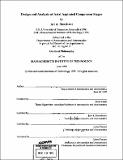| dc.contributor.advisor | Mark Drela. | en_US |
| dc.contributor.author | Merchant, Ali A. (Ali Abbas) | en_US |
| dc.contributor.other | Massachusetts Institute of Technology. Dept. of Aeronautics and Astronautics. | en_US |
| dc.date.accessioned | 2005-08-22T20:36:32Z | |
| dc.date.available | 2005-08-22T20:36:32Z | |
| dc.date.copyright | 1999 | en_US |
| dc.date.issued | 1999 | en_US |
| dc.identifier.uri | http://hdl.handle.net/1721.1/9362 | |
| dc.description | Thesis (Ph.D.)--Massachusetts Institute of Technology, Dept. of Aeronautics and Astronautics, 1999. | en_US |
| dc.description | Includes bibliographical references (p. 145-150). | en_US |
| dc.description.abstract | The pressure ratio of axial compressor stages can be significantly increased by controlling the development of blade and endwall boundary layers in regions of adverse pressure gradient by means of boundary layer suction. This concept is validated and demonstrated through the design and analysis of two unique aspirated compressor stages: a low-speed stage with a design pressure ratio of 1.6 at a tip speed of 750 ft/s, and a high-speed stage with a design pressure ratio of 3.5 at a tip speed of 1500 ft/s. The aspirated compressor stages were designed using a new procedure which is a synthesis of low speed and high speed blade design techniques combined with a flexible inverse design method which enabled precise independent control over the shape of the blade suction and pressure surfaces. Integration of the boundary layer suction calculation into the overall design process is an essential ingredient of the new procedure. The blade design system consists of two axisymmetric through-flow codes coupled with a quasi three-dimensional viscous cascade plane code with inverse design capability. Validation of the completed designs were carried out with three-dimensional Euler and Navier-Stokes calculations. A single spanwise slot on the blade suction surface is used to bleed the boundary layer. The suction mass flow requirement for the low-speed and high-speed stages are 1 % and 4% of the inlet mass flow, respectively. Additional suction between 1-2% is also required on the compressor end walls near shock impingement locations. The rotor is modeled with a tip shroud to eliminate tip clearance effects and to discharge the suction flow radially from the flowpath. Three-dimensional viscous evaluation of the designs showed good agreement with the quasi three-dimensional design intent, except in the endwall regions. The suction requirements predicted by the quasi three-dimensional calculation were confirmed by the three-dimensional viscous calculations. The three-dimensional viscous analysis predicted a peak pressure ratio of 1.59 at an isentropic efficiency of 89% for the low-speed stage, and a peak pressure ratio of 3.68 at an isentropic efficiency of 94% for the high-speed rotor. | en_US |
| dc.description.statementofresponsibility | by Ali M. Merchant. | en_US |
| dc.format.extent | 157 p. | en_US |
| dc.format.extent | 9453612 bytes | |
| dc.format.extent | 9453364 bytes | |
| dc.format.mimetype | application/pdf | |
| dc.format.mimetype | application/pdf | |
| dc.language.iso | eng | en_US |
| dc.publisher | Massachusetts Institute of Technology | en_US |
| dc.rights | M.I.T. theses are protected by copyright. They may be viewed from this source for any purpose, but reproduction or distribution in any format is prohibited without written permission. See provided URL for inquiries about permission. | en_US |
| dc.rights.uri | http://dspace.mit.edu/handle/1721.1/7582 | |
| dc.subject | Aeronautics and Astronautics. | en_US |
| dc.title | Design and analysis of axial aspirated compressor stages | en_US |
| dc.type | Thesis | en_US |
| dc.description.degree | Ph.D. | en_US |
| dc.contributor.department | Massachusetts Institute of Technology. Department of Aeronautics and Astronautics | |
| dc.identifier.oclc | 44598131 | en_US |

